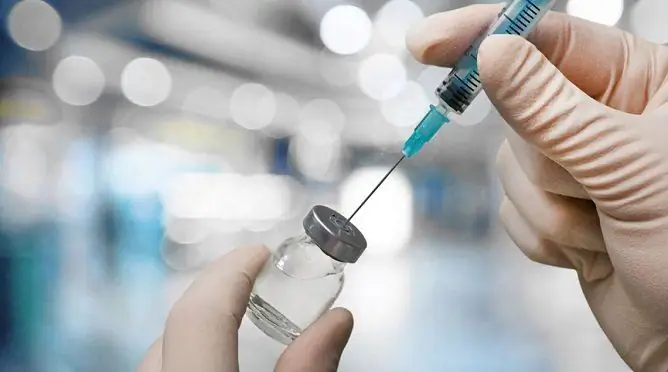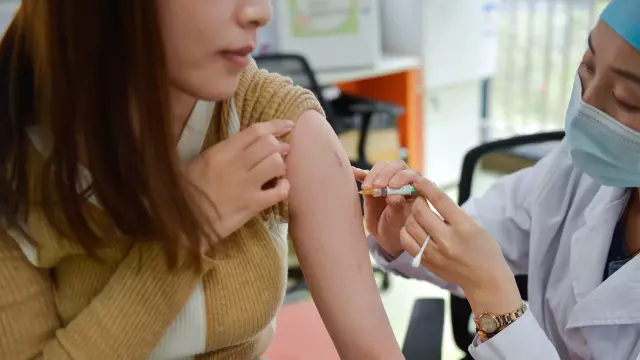- Author Rachel Wainwright [email protected].
- Public 2023-12-15 07:39.
- Last modified 2025-11-02 20:14.
Human papillomavirus
The content of the article:
- Causes and risk factors
- Forms
- Stages
- Symptoms of Human Papillomavirus Infection
- Features of the course of the disease in children
- Diagnostics
- Human papillomavirus treatment
- Possible complications and consequences
- Forecast
- Prevention
Human papillomavirus is a common infection of the skin and urinary tract. As a rule, the infectious process resolves itself within a few months, and in immunocompromised individuals - within two years. Many papillomaviruses cause papillomas - papillary growths of the epithelium of the skin and mucous membranes, which are commonly called warts. With a long chronic course of infection, some types of human papillomavirus provoke carcinogenesis.

Human papillomavirus
Causes and risk factors
The human papillomavirus is localized in the basal layer of the epithelium. Viral DNA is inserted into the cellular genome, infected basal cells serve as a source of infection for epithelial cells. Virulent viral particles are found in the particles of the integumentary epithelium, urine, semen, saliva and secretions of the mucous membranes of the urogenital and respiratory tract.
Transmission of the human papillomavirus occurs through contact with infected particles of the skin and mucous membranes of the virus carrier in the presence of microtrauma on the surface of the external and internal integuments. Most often, papillomavirus infection occurs during intercourse or bodily contact of the genitals without penetration, with the peak of infections occurring during the first 4-6 years of sexual activity. The likelihood of infection increases due to the following factors:
- early onset of sexual activity;
- a large number of births;
- frequent change of sexual partners.
The human papillomavirus can also be transmitted by household means - through general hygiene items, underwear and common places, less often - through kissing and touching. There are known cases of self-infection when damaged areas of the skin are damaged during shaving, manicure or pedicure.

The papilloma virus can be transmitted in the household - through general hygiene items
The activation of the virus is promoted by the suppressed state of the immune system, concomitant infections and some other factors:
- hormonal disorders;
- long-term use of combined oral contraceptives;
- endocrine pathologies and especially diabetes mellitus;
- smoking;
- malnutrition, in particular deficiency of vitamins A, C, E, B 6 and B 12;
- chronic stress;
- frequent contact with toxic substances;
- living in an ecologically unfavorable place;
- genetic predisposition.
Forms
More than 170 strains of papillomaviruses of varying degrees of pathogenicity are known. Papillomavirus infection of the genitals most often manifests itself in the form of exophytic (external) fibroepithelial formations on a thin stalk or on a broad base - genital and papillary warts, or anogenital warts. Typical localizations of genital warts include areas with maceration:
- external opening of the urethra;
- perianal area and anus;
- head, foreskin, bridle, coronal groove and shaft of the penis;
- scrotum;
- the vestibule of the vagina, labia and cervix in women.
With a latent course of the infectious process, endophytic growths of epithelial tissue predominate - intraepithelial, or flat warts growing inward. Microscopic changes in cells are limited to dyskeratosis or are completely absent.

Human papillomavirus infection of the genitals most often manifests itself in the form of genital warts
In the case of non-genital localization of the human papillomavirus, the skin, organs of the urinary tract - the urethra, ureters, bladder, renal pelvis are affected. Less commonly, infections of the mucous membranes of the mouth (types 13 and 32) and the respiratory tract (types 6, 11, and 30), including the nasopharynx, paranasal sinuses, larynx and vocal cords, are sometimes involved, and sometimes the trachea and bronchi are involved.
With skin lesions, the appearance of various types of warts is characteristic. There is a relationship between the serotype of the pathogen and the type of papillomas:
- flat warts: strains 3, 10, 28, 49;
- vulgar warts: strains 2, 4, 26, 27, 29, 57;
- plantar warts: strains 1, 2, 4.
About 40 serotypes cause cervical leukoplakia and anaplastic changes in the cervical canal. In everyday life, anaplastic transformations of the cervical epithelium are called cervical dysplasia. In clinical practice, this condition is defined as "squamous intraepithelial lesion"; until 2012, the term “cervical intraepithelial neoplasia” was used.
The relationship of some strains of papillomaviruses with cervical cancer has been reliably established. According to WHO, viral particles are present in 58-95% of histological preparations of intraepithelial carcinoma of the cervix, with up to 50% of cases of the disease occurring in strain 16 and about 10% in strain 18. In different countries, up to 90% of women with cervical dysplasia are infected human papillomavirus. In the Russian Federation, squamous intraepithelial lesions are detected in 15-34% of the sexually active female population, depending on the region.

The link between human papillomavirus and cervical cancer has been reliably established
There is also a relationship between persistent human papillomavirus infection and cancers of the vulva, vagina, penis and anal area, as well as bowenoid papulosis, a benign neoplasia of the penis. When genital warts are detected in the anogenetic region, papillomavirus is detected in 50-80% of patients. Almost half of cases of malignant neoplasms in the perianal region are associated with papillomavirus infection; it is also associated with Bowen's disease, a precancerous skin condition.
Depending on the degree of oncogenic risk, four types of human papillomaviruses are distinguished:
- viruses that do not cause cancer: types 1, 2, 4, 5, 10, 28, 49;
- low-oncogenic: types 3, 6, 11, 13, 32, 34, 40, 41, 42, 43, 44, 51;
- medium oncogenic: types 26, 30, 35, 52, 53, 56, 58, 65;
- highly oncogenic viruses: types 16, 18, 31, 33, 39, 45, 50, 59, 59, 62, 64, 68, 70, 73.
The possibility of mutation of a serotype with low or medium risk into highly oncogenic strains is not excluded.
Stages
Depending on the depth of changes in the epithelial tissue during papillomavirus infection of the cervix, five stages of the anaplastic process are distinguished:
- Coilocytosis. During cytological examination of a cervical smear, coilocytes are found - cells of the squamous epithelium infected with the human papillomavirus, which differ in a slightly enlarged nucleus, surrounded by a light rim and a large number of vacuoles. For coylocytes, as well as for atypical cells, basophilia is characteristic - cells are well stained with basic dyes.
- Weak dysplasia. The epithelium of the cervix is affected by a third of the thickness. In a smear, coylocytes are detected in combination with more-nucleated and multinucleated atypical cells.
- Moderate dysplasia. Up to two-thirds of the epithelial layer is affected. In addition to the presence of atypical cells in the smear, the polarity of the layers is disturbed.
- Severe dysplasia, or non-invasive carcinoma in situ (cancer in situ). The epithelium of the cervix is affected by more than two-thirds of the thickness. A large number of atypical cells are found, some of them show signs of division.
- Invasive cervical cancer. Actively dividing atypical cells grow through the basement membrane.

Stages of the neoplastic process of the cervix with HPV
The progression of papillomavirus genital infection develops slowly. The incubation period lasts from several months to two years, depending on the state of immunity. From the moment of infection until signs of neoplasia appear, it takes 5 to 30 years. With strong immunosuppression, a malignant neoplasm can develop within a year.
Symptoms of Human Papillomavirus Infection
The symptoms of the human papillomavirus, or rather, the disease caused by it, depend on the affected area, the stage of the pathological process and the presence of concomitant infections. A reliable sign of the presence of human papilloma virus in the body is the appearance of warts, intraepithelial papillomas and genital warts. Multiple warts often coalesce to form cauliflower and rooster comb-like outgrowths.
Squamous intraepithelial lesion of the cervix in women, caused by the human papillomavirus, is usually hidden. Nonspecific manifestations of the disease appear at a late stage: patients are disturbed by abundant mucous leucorrhoea, bloody discharge from the vagina, pulling pains in the lower abdomen and discomfort during intercourse.

Pulling pains in the lower abdomen, bloody discharge may indicate a papillomavirus infection in a woman
In combined infections, the symptoms of human papillomavirus are combined with signs of other sexually transmitted infections. Patients complain of itching and burning in the external genital area, dysuric disorders, purulent and foamy discharge from the vagina and urethra. In women, human papillomavirus infection is often accompanied by candidiasis. In case of urinary tract damage, blood streaks periodically appear in the urine.
Features of the course of the disease in children
Babies can become infected with the human papillomavirus from the mother when passing through the mouth, during pregnancy through the placenta, during breastfeeding, and also through the household route. Typical manifestations of papillomavirus infection in childhood are papillomas of the oral mucosa and juvenile papillomatosis of the larynx, which causes hoarseness and, in severe cases, difficulty in breathing. Also, the appearance of genital warts or latent carriage of mucocutaneous types of papillomavirus in a child is not excluded.

Human papillomavirus can be transmitted to a child from the mother during childbirth
Diagnostics
Early detection of human papillomavirus infection is difficult due to the long incubation period and long latent course. The starting point of a diagnostic search is usually the detection of anogenital warts.
Screening diagnostics of cervical squamous intraepithelial lesions in women involves a visual examination of the cervix and cytological examination of a cervical Pap smear (PAP test, SMEAR test). If atypical cells are found in the smear, the patient is sent for colposcopy - examination of the cervix under multiple magnification and samples with acetic acid and Lugol's solution. After treatment of the altered epithelium with acetic acid, discolored spots and areas with a pearl color appear, and the uneven absorption of iodine by atypical cells gives a picture of puncture and mosaic.

PAP test reveals changes in the cervix in women with human papillomavirus infection
To identify and type the human papillomavirus, laboratory studies of scrapings from the surface of the cervix and vagina are carried out: PCR diagnostics with type-specific hybridization or analysis for the human papillomavirus using the Digene method, the advantage of which is the differentiation of clinically significant titers of highly oncogenic papillomaviruses with latent infection with low-oncogenic strains prone to self-resolution. Recently, attempts have been made to use urine for PCR tests.
To exclude concomitant infections, PCR diagnostics of sexually transmitted diseases is simultaneously performed. If the epithelial layer is damaged in depth from two-thirds or more, an immunohistochemical study of a biopsy of the cervix for tumor markers is shown.
In men, if warts are detected in the perineum, urethroscopy is performed; if papillomatosis of the urinary tract is suspected, urethrocystoscopy is prescribed for representatives of both sexes. With the help of laboratory tests, the type and titer of the virus is determined; histological examination of samples of affected tissues allows one to judge the severity of the disease and assess the level of oncogenic risk.

In men, if HPV is suspected, urethroscopy is performed
Flat, vulgar and plantar warts are diagnosed by a dermatologist on the basis of visual examination and dermatoscopy.
Human papillomavirus treatment
At the moment, methods of radical treatment of human papillomavirus infection have not been developed. All existing schemes are aimed at inactivating the pathogen and strengthening antiviral immunity; warts, condylomas and dysplasias are removed using minimally invasive methods. Surgical excision, conization and removal of the cervix are rarely practiced and mainly when there is a reasonable suspicion of oncopathology.
In clinical practice, various methods are used to remove papillomas, anogenital warts and dysplasias without signs of malignancy:
- electrocoagulation and electrosurgical excision;
- radio wave and ultrasonic destruction;
- plasma coagulation;
- chemical moxibustion;
- laser vaporization;
- cryodestruction (freezing of growths with liquid nitrogen).
To date, the most promising treatment strategy for genital papillomavirus infection, which practically excludes relapses, is the destruction of dysplasia foci through the combined use of cryodestruction and plasma coagulation and stimulation of local immunity. Since the likelihood of contracting the human papillomavirus with a single sexual intercourse is estimated at 65-70%, both partners must undergo therapy. At the same time, concomitant diseases and dysbiotic conditions are treated.
The initial stage of cervical neoplasia usually goes away on its own. If within six months the signs of dysplasia do not disappear, the question of drug therapy is decided. With moderately severe cervical dysplasia, fortifying agents, immunomodulators and topical preparations containing interferon are prescribed in the form of ointments, tampons, douching solutions, vaginal suppositories and tablets.

With neoplasia of the cervix caused by HPV, the use of fortifying agents in the form of ointments, suppositories, tampons is indicated
General antiviral therapy is indicated in the late stages of squamous intraepithelial lesions in the detection of highly oncogenic strains of human papillomavirus. The therapeutic regimens include interferons, interferon inducers and local cytostatics.
Possible complications and consequences
The probability of malignancy of cervical neoplasia caused by human papillomavirus is estimated at 0.8%; the risk of developing anogenital cancer and penis cancer is an order of magnitude lower. Anogenous warts and large areas of dysplasia in women are easily injured during gynecological examination and sexual intercourse and complicate the course of labor.
After removal of genital warts by electrosurgery and laser vaporization, ulceration, scarring and secondary infection of wounds are sometimes observed. With sufficient qualifications of the surgeon and following the recommendations for postoperative care, there are practically no complications.
Forecast
With a satisfactory state of immunity and in the absence of concomitant diseases, condylomas and dysplasia are successfully cured, however, relapses are possible against the background of a weakening of the body's defenses. In the case of a mixed infection, the duration of treatment is approximately threefold.
Prevention
Specific prophylaxis of human papillomavirus infection is possible only before the first sexual contact, in extreme cases - at the beginning of sexual activity. In many countries, adolescent girls are vaccinated against the most common stamps of highly oncogenic papillomaviruses. At the age of 9 to 13, girls are given a three-fold vaccination against human papillomavirus types 16 and 18. Licensed vaccines have fewer contraindications and are well tolerated.

The optimal prevention of HPV types 16 and 18 for girls 9-13 years old is vaccination
Condoms do not guarantee protection against the human papillomavirus, but they reduce the likelihood of infection, so it is advisable for sexually active people to refrain from promiscuous sexual intercourse. In changing rooms, saunas and public toilets, direct skin contact with the seat should not be allowed, and toiletries, towels and underwear must remain personal items.
Prevention of clinical manifestations of infection after primary infection with human papillomavirus is reduced to strengthening the immune system and preventing hormonal disorders. It is important to lead a healthy lifestyle, quit smoking, eat a balanced diet and an optimal daily regimen, avoid stress, and treat urinary tract infections in a timely manner. Women should also remember that a specialist should be involved in the selection of oral contraceptives.
YouTube video related to the article:

Anna Kozlova Medical journalist About the author
Education: Rostov State Medical University, specialty "General Medicine".
The information is generalized and provided for informational purposes only. At the first sign of illness, see your doctor. Self-medication is hazardous to health!






